Buildability Analysis of 3D Concrete Printing Process: A Parametric Study Using Design of Experiment Approach
Abstract
:1. Introduction
- Analyze the effect of different parameters on buildability.
- Effect of each factor and its sensitivity level concerning other factors.
- Predict the model response for the configuration that was not simulated to save the execution time and to have real-time answers.
- Find the combination of input factors to maximize the final response.
- Develop the low order polynomial regression equation for each printing parameter and geometrical factors.
2. Methodology
2.1. DOE Approach for Parametric Study
2.2. Geometrical Factors and Design Matrix
2.3. Printing Parameters and Design Matrix
2.4. Numerical and Simulation Model
3. Results and Discussions
3.1. Geometrical Parameters
3.2. Printing Parameters
4. Conclusions and Future Recommendation
- -
- Buildability is sensitive to the geometrical parameters of printed structure thickness, length of the printed structure, and its geometrical design.
- -
- The geometrical design factor is a more sensitive parameter to buildability, followed by the width of the printed wall and the length.
- -
- The buildability increases with an increase in thickness of the printed structure while decreasing with the length the decreasing with an increase in the length.
- -
- The stability of the structures increases when we move from sharp corners (such as square geometry) to rounded corners.
- -
- In the considered geometries, circular geometry resulted in the highest buildability, followed by fillet (rounded corner) square shape. In contrast, the lowest buildability is reported for square shapes with sharp corners (90 degrees).
- -
- Buildability is sensitive to both printing speed and printed layer height in the low range of the value. In contrast, layer height is the more sensitive parameter to buildability, followed by printing velocity.
- -
- Buildability increases with a decrease in printing speed and reduction in the printed layer height. Both contribute to a lower vertical building rate of the structure and hence provide more time for the material to be stable.
- -
- The maximum buildability of 486 mm (81% of the designed height) was achieved at low printing speed and lowest layer height.
- -
- After a specific upper limit of printing speed and layer height, the buildability becomes independent, as the material did not find enough time to develop its time-dependent strength.
- -
- Like the higher limit, the effect of printing velocity on buildability is negligible after a specific lower limit of printing speed because the materials had enough time to develop their properties.
- -
- The buildability can be increased with the decrease in print speed or layer height. However, other experimental factors need to be considered. For example, the reduction in printing speed and layer height might increase printing time and, hence, printing cost. Similarly, a slow printing speed might result in lower adhesion between the layers. Again, the lower layer height leads to high printing energy and printing cost.
Future Recommendation
Author Contributions
Funding
Data Availability Statement
Conflicts of Interest
References
- Khosravani, M.R.; Božić, Ž.; Zolfagharian, A.; Reinicke, T. Failure analysis of 3D-printed PLA components: Impact of manufacturing defects and thermal ageing. Eng. Fail. Anal. 2022, 136, 106214. [Google Scholar] [CrossRef]
- Somireddy, M.; Singh, C.V.; Czekanski, A. Mechanical behaviour of 3D printed composite parts with short carbon fiber reinforcements. Eng. Fail. Anal. 2020, 107, 104232. [Google Scholar] [CrossRef]
- Muflikhun, M.A.; Sentanu, D.A. Characteristics and performance of carabiner remodeling using 3D printing with graded filler and different orientation methods. Eng. Fail. Anal. 2021, 130, 105795. [Google Scholar] [CrossRef]
- Al Rashid, A.; Khan, S.A.; Al-Ghamdi, S.G.; Koç, M. Additive manufacturing: Technology, applications, markets, and opportunities for the built environment. Autom. Constr. 2020, 118, 103268. [Google Scholar] [CrossRef]
- Khan, S.A.; Koç, M.; Al-Ghamdi, S.G. Sustainability assessment, potentials and challenges of 3D printed concrete structures: A systematic review for built environmental applications. J. Clean. Prod. 2021, 303, 127027. [Google Scholar] [CrossRef]
- Wang, W.; Zhang, D.; Lu, F.; Wang, S.-C.; Tang, F. Experimental study and numerical simulation of the damage mode of a square reinforced concrete slab under close-in explosion. Eng. Fail. Anal. 2013, 27, 41–51. [Google Scholar] [CrossRef]
- Firat, M.; Kozan, R.; Ozsoy, M.; Mete, O.H. Numerical modeling and simulation of wheel radial fatigue tests. Eng. Fail. Anal. 2009, 16, 1533–1541. [Google Scholar] [CrossRef]
- Vantyghem, G.; Ooms, T.; De Corte, W. FEM modelling techniques for simulation of 3D concrete printing. In Proceedings of the Fib Symposium 2020: Concrete Structures for Resilient Society, Shanghai, China, 22–24 November 2020; pp. 964–972. [Google Scholar]
- Panda, B.; Tay, Y.W.D.; Paul, S.C.; Tan, M.J. Current challenges and future potential of 3D concrete printing. Mater. Werkst. 2018, 49, 666–673. [Google Scholar] [CrossRef]
- Nguyen-Van, V.; Panda, B.; Zhang, G.; Nguyen-Xuan, H.; Tran, P. Digital design computing and modelling for 3-D concrete printing. Autom. Constr. 2021, 123, 103529. [Google Scholar] [CrossRef]
- Jayathilakage, R.; Sanjayan, J.; Rajeev, P. Characterizing Extrudability for 3D Concrete Printing Using Discrete Element Simulations. In Proceedings of the Second RILEM International Conference on Concrete and Digital Fabrication: Digital Concrete 2020, Online, 6–9 July 2020; Springer International Publishing: Cham, Switzerland, 2020; pp. 290–300. [Google Scholar] [CrossRef]
- Chen, Y.; Li, Z.; Figueiredo, S.C.; Çopuroğlu, O.; Veer, F.; Schlangen, E. Limestone and Calcined Clay-Based Sustainable Cementitious Materials for 3D Concrete Printing: A Fundamental Study of Extrudability and Early-Age Strength Development. Appl. Sci. 2019, 9, 1809. [Google Scholar] [CrossRef] [Green Version]
- Jayathilakage, R.; Rajeev, P.; Sanjayan, J.G. Yield stress criteria to assess the buildability of 3D concrete printing. Constr. Build. Mater. 2020, 240, 117989. [Google Scholar] [CrossRef]
- Khan, S.A.; Al-Ghamdi, S.G. Renewable and Integrated Renewable Energy Systems for Buildings and Their Environmental and Socio-Economic Sustainability Assessment; Springer International Publishing: Cham, Switzerland, 2021; pp. 127–144. [Google Scholar]
- Roussel, N.; Bessaies-Bey, H.; Kawashima, S.; Marchon, D.; Vasilic, K.; Wolfs, R. Recent advances on yield stress and elasticity of fresh cement-based materials. Cem. Concr. Res. 2019, 124, 105798. [Google Scholar] [CrossRef]
- Suiker, A. Mechanical performance of wall structures in 3D printing processes: Theory, design tools and experiments. Int. J. Mech. Sci. 2018, 137, 145–170. [Google Scholar] [CrossRef] [Green Version]
- Wolfs, R.J.M.; Suiker, A.S.J. Structural failure during extrusion-based 3D printing processes. Int. J. Adv. Manuf. Technol. 2019, 104, 565–584. [Google Scholar] [CrossRef] [Green Version]
- Wolfs, R.J.M.; Bos, F.P.; Salet, T.A.M. Early age mechanical behaviour of 3D printed concrete: Numerical modelling and experimental testing. Cem. Concr. Res. 2018, 106, 103–116. [Google Scholar] [CrossRef]
- Wolfs, R.J.M.; Bos, F.P.; Salet, T.A.M. Triaxial compression testing on early age concrete for numerical analysis of 3D concrete printing. Cem. Concr. Compos. 2019, 104, 103344. [Google Scholar] [CrossRef]
- Vantyghem, G.; Ooms, T.; De Corte, W. VoxelPrint: A Grasshopper plug-in for voxel-based numerical simulation of concrete printing. Autom. Constr. 2021, 122, 103469. [Google Scholar] [CrossRef]
- Ooms, T.; Vantyghem, G.; Van Coile, R.; De Corte, W. A parametric modelling strategy for the numerical simulation of 3D concrete printing with complex geometries. Addit. Manuf. 2021, 38, 101743. [Google Scholar] [CrossRef]
- Janßen, H.; Edelmann, A.; Mildebrath, T.; Müller, P.; Lehnert, W.; Stolten, D. Design and experimental validation of an HT-PEFC stack with metallic BPP. Int. J. Hydrogen Energy 2018, 43, 18488–18497. [Google Scholar] [CrossRef]
- Shuaeib, F.; Hamouda, A.; Wong, S.; Umar, R.R.; Ahmed, M.M. A new motorcycle helmet liner material: The finite element simulation and design of experiment optimization. Mater. Des. 2007, 28, 182–195. [Google Scholar] [CrossRef]
- Siddhartha; Patnaik, A.; Bhatt, A.D. Mechanical and dry sliding wear characterization of epoxy–TiO2 particulate filled functionally graded composites materials using Taguchi design of experiment. Mater. Des. 2011, 32, 615–627. [Google Scholar] [CrossRef]

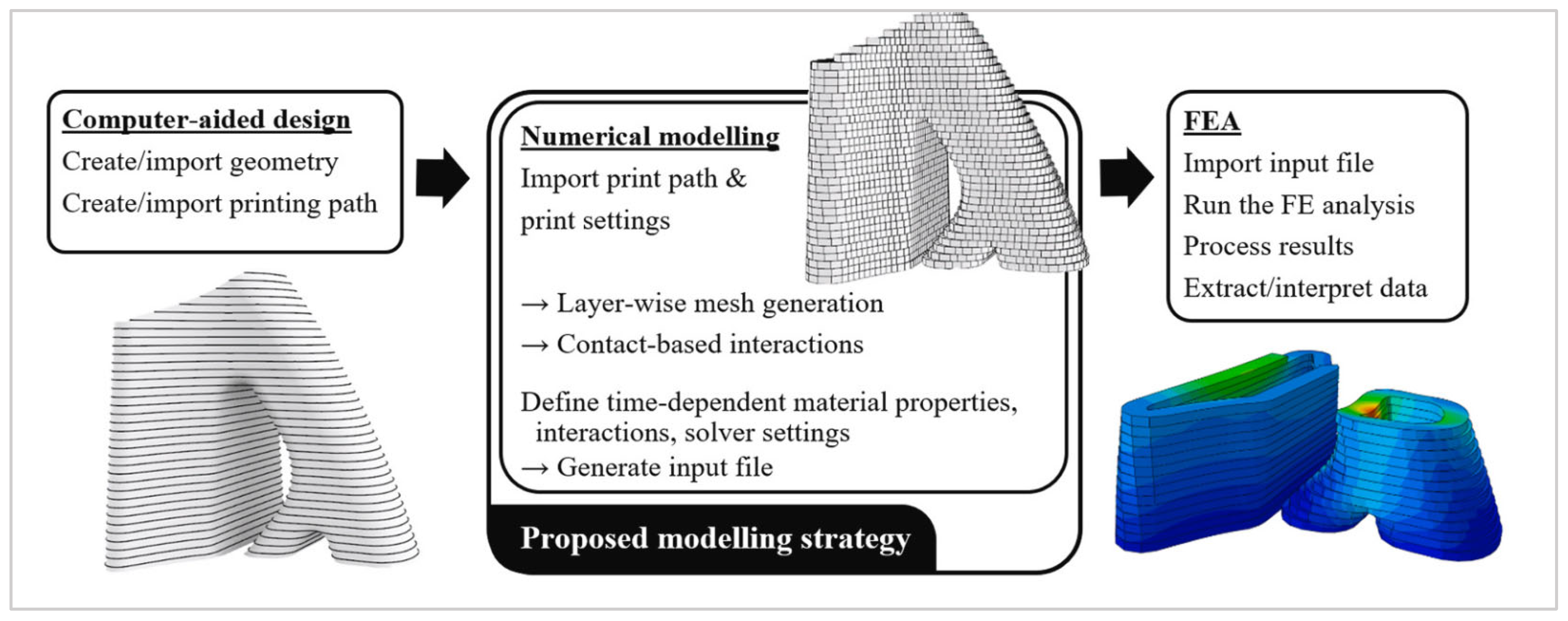
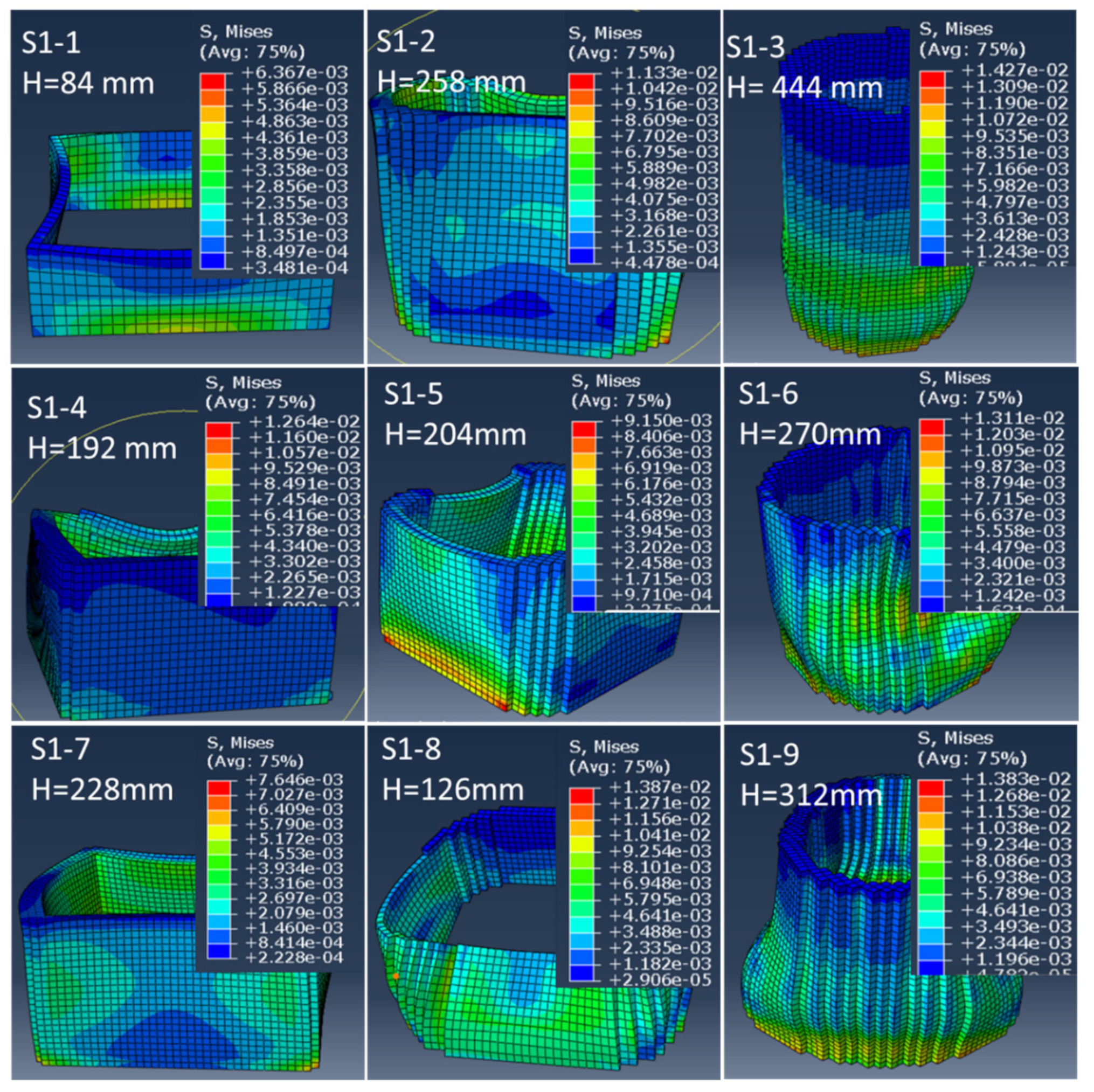
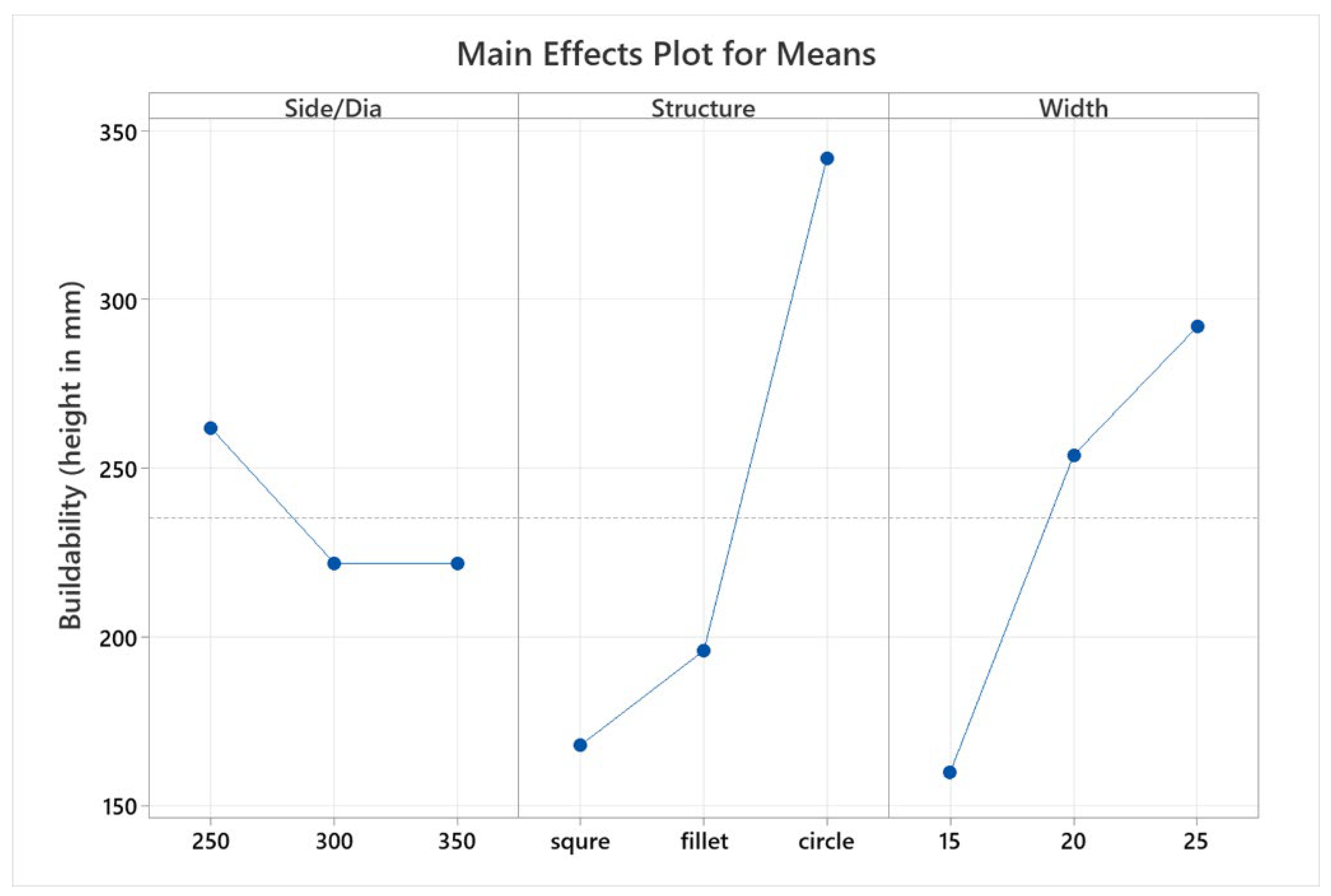


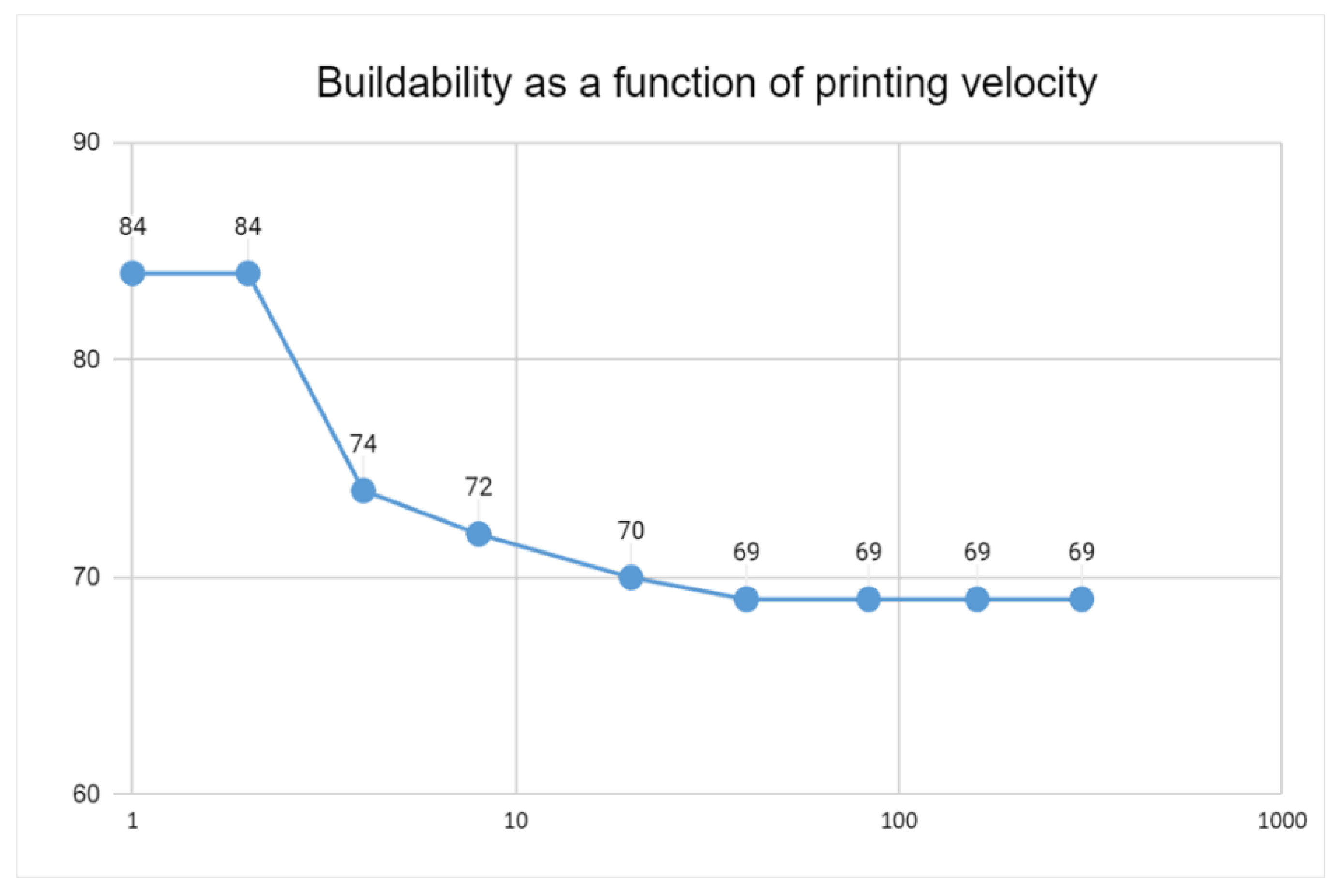
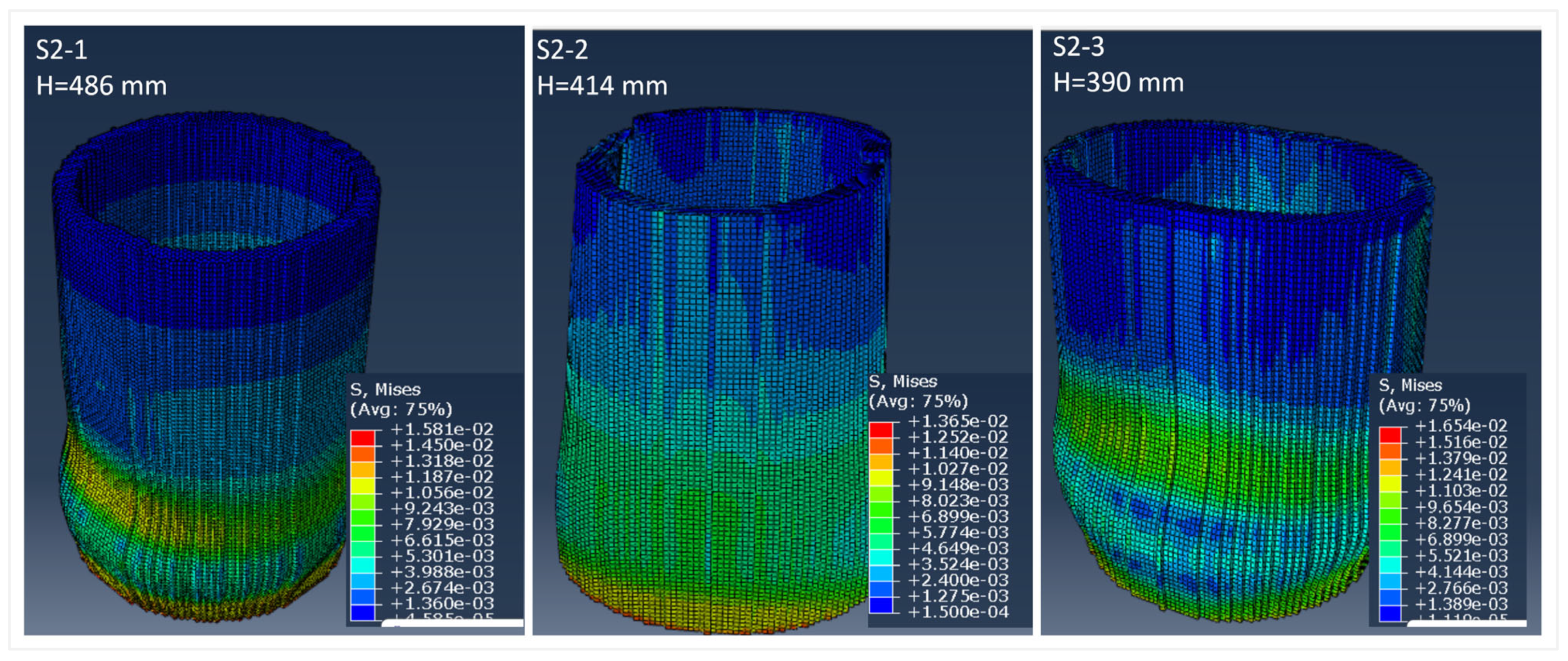
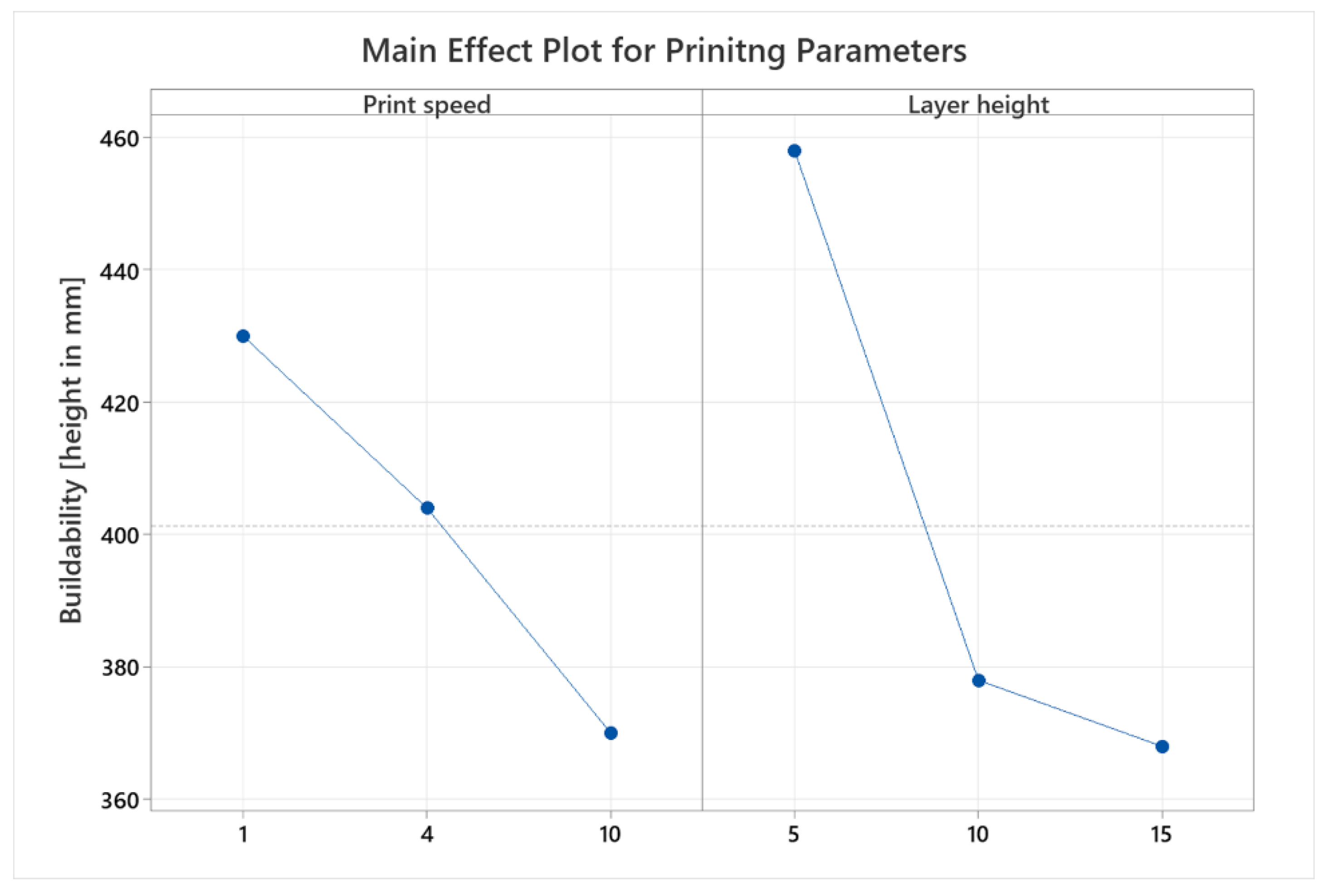
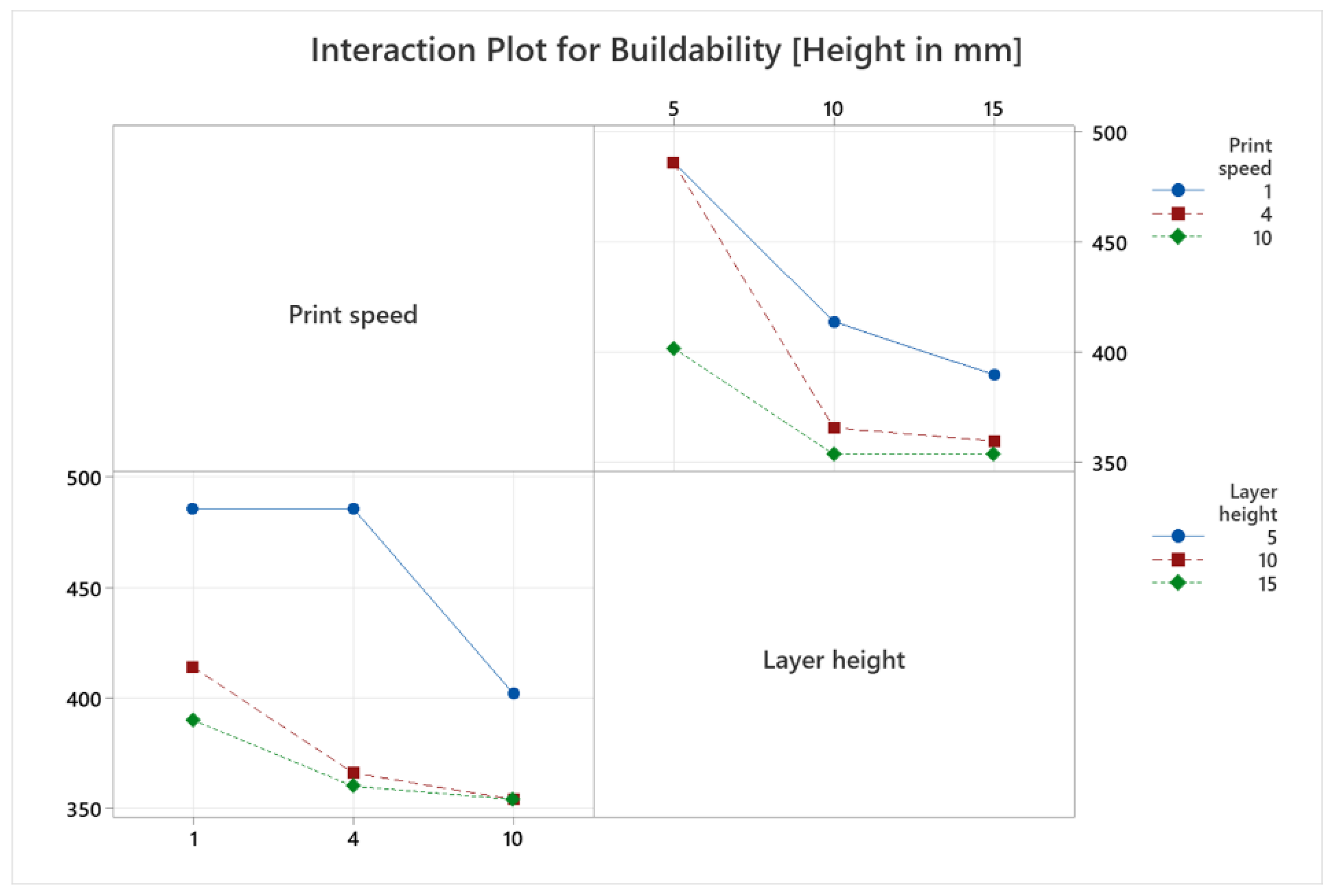
| d [Side/Diameter] | Geometry | Width (mm) |
|---|---|---|
| −1 | −1 | −1 |
| −1 | 0 | 0 |
| −1 | 1 | 1 |
| 0 | −1 | 0 |
| 0 | 0 | 1 |
| 0 | 1 | −1 |
| 1 | −1 | 1 |
| 1 | 0 | −1 |
| Print Speed [mm/s] | Layer Height [mm] |
|---|---|
| −1 | −1 |
| −1 | 0 |
| −1 | +1 |
| 0 | −1 |
| 0 | 0 |
| 0 | +1 |
| +1 | −1 |
| +1 | 0 |
| +1 | +1 |
| S. No | Length (Side/Diameter) [mm] | Structure | Width [mm] | Buildability [Achieved Steps Out of 100] | Buildability [Achieved Height in mm] |
|---|---|---|---|---|---|
| S1-1 | 250 | square | 15 | 14 | 84 |
| S1-2 | 250 | fillet | 20 | 43 | 258 |
| S1-3 | 250 | circle | 25 | 74 | 444 |
| S1-4 | 300 | square | 20 | 32 | 192 |
| S1-5 | 300 | fillet | 25 | 34 | 204 |
| S1-6 | 300 | circle | 15 | 45 | 270 |
| S1-7 | 350 | square | 25 | 38 | 228 |
| S1-8 | 350 | fillet | 15 | 21 | 126 |
| S1-9 | 350 | circle | 20 | 52 | 312 |
| Level | Side/Dia | Structure | Width |
|---|---|---|---|
| 1 | 262.0 | 168.0 | 160.0 |
| 2 | 222.0 | 196.0 | 254.0 |
| 3 | 222.0 | 342.0 | 292.0 |
| Delta | 40.0 | 174.0 | 132.0 |
| Rank | 3 | 1 | 2 |
| S. No | Print Speed [mm/s] | Layer Height [mm] | Buildability [Achieved Steps Out of 100] | Buildability [Achieved Height in mm] |
|---|---|---|---|---|
| S2-1 | 1 | 5 | 81 | 486 |
| S2-2 | 1 | 10 | 69 | 414 |
| S2-3 | 1 | 15 | 65 | 390 |
| S2-4 | 4 | 5 | 81 | 486 |
| S2-5 | 4 | 10 | 61 | 366 |
| S2-6 | 4 | 15 | 60 | 360 |
| S2-7 | 10 | 5 | 67 | 402 |
| S2-8 | 10 | 10 | 59 | 354 |
| S2-9 | 10 | 15 | 59 | 354 |
| Level | Print Speed | Layer Height |
|---|---|---|
| 1 | 430.0 | 458.0 |
| 2 | 404.0 | 378.0 |
| 3 | 370.0 | 368.0 |
| Delta | 60.0 | 90.0 |
| Rank | 2 | 1 |
Disclaimer/Publisher’s Note: The statements, opinions and data contained in all publications are solely those of the individual author(s) and contributor(s) and not of MDPI and/or the editor(s). MDPI and/or the editor(s) disclaim responsibility for any injury to people or property resulting from any ideas, methods, instructions or products referred to in the content. |
© 2023 by the authors. Licensee MDPI, Basel, Switzerland. This article is an open access article distributed under the terms and conditions of the Creative Commons Attribution (CC BY) license (https://creativecommons.org/licenses/by/4.0/).
Share and Cite
Khan, S.A.; Koç, M. Buildability Analysis of 3D Concrete Printing Process: A Parametric Study Using Design of Experiment Approach. Processes 2023, 11, 782. https://doi.org/10.3390/pr11030782
Khan SA, Koç M. Buildability Analysis of 3D Concrete Printing Process: A Parametric Study Using Design of Experiment Approach. Processes. 2023; 11(3):782. https://doi.org/10.3390/pr11030782
Chicago/Turabian StyleKhan, Shoukat Alim, and Muammer Koç. 2023. "Buildability Analysis of 3D Concrete Printing Process: A Parametric Study Using Design of Experiment Approach" Processes 11, no. 3: 782. https://doi.org/10.3390/pr11030782
APA StyleKhan, S. A., & Koç, M. (2023). Buildability Analysis of 3D Concrete Printing Process: A Parametric Study Using Design of Experiment Approach. Processes, 11(3), 782. https://doi.org/10.3390/pr11030782






